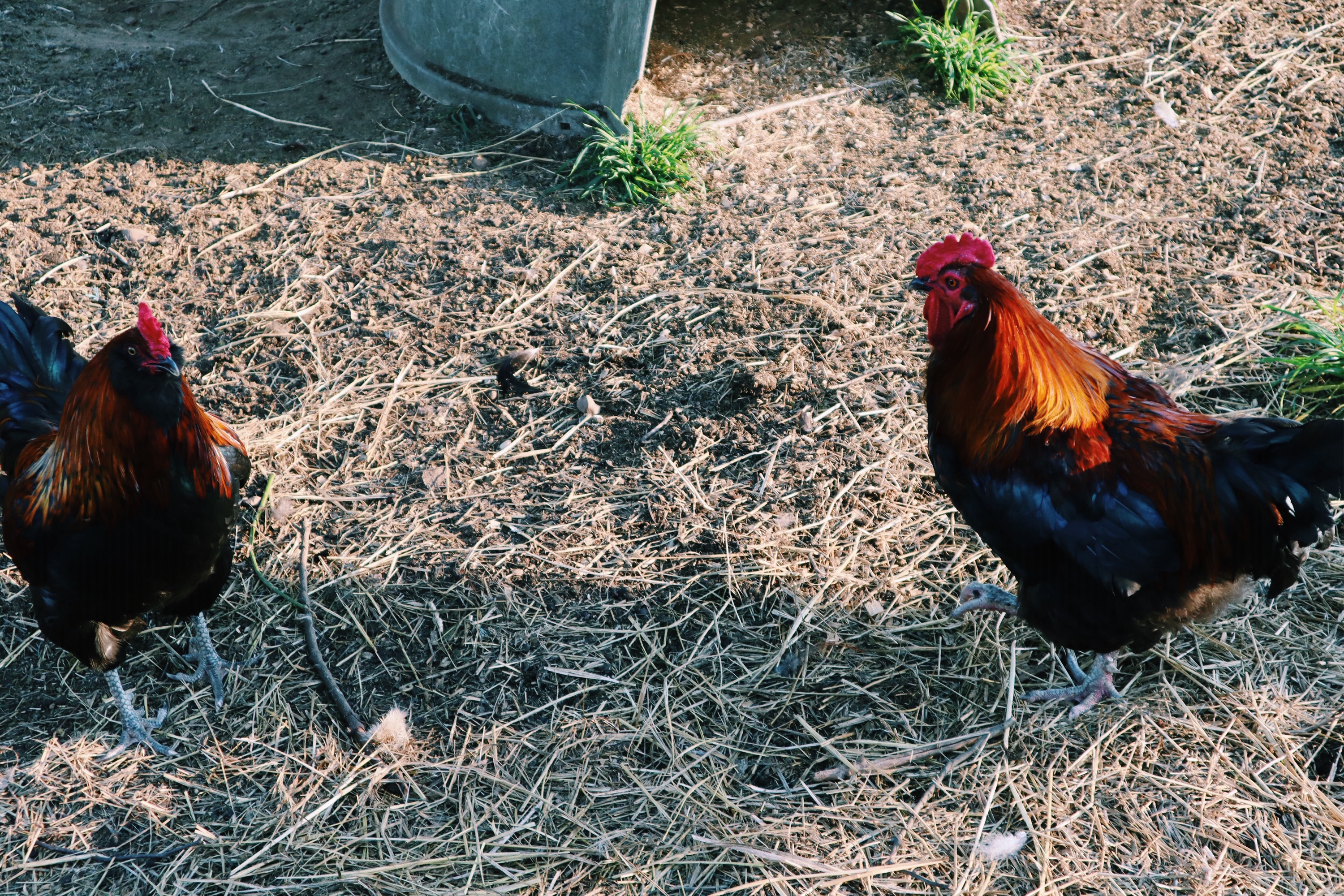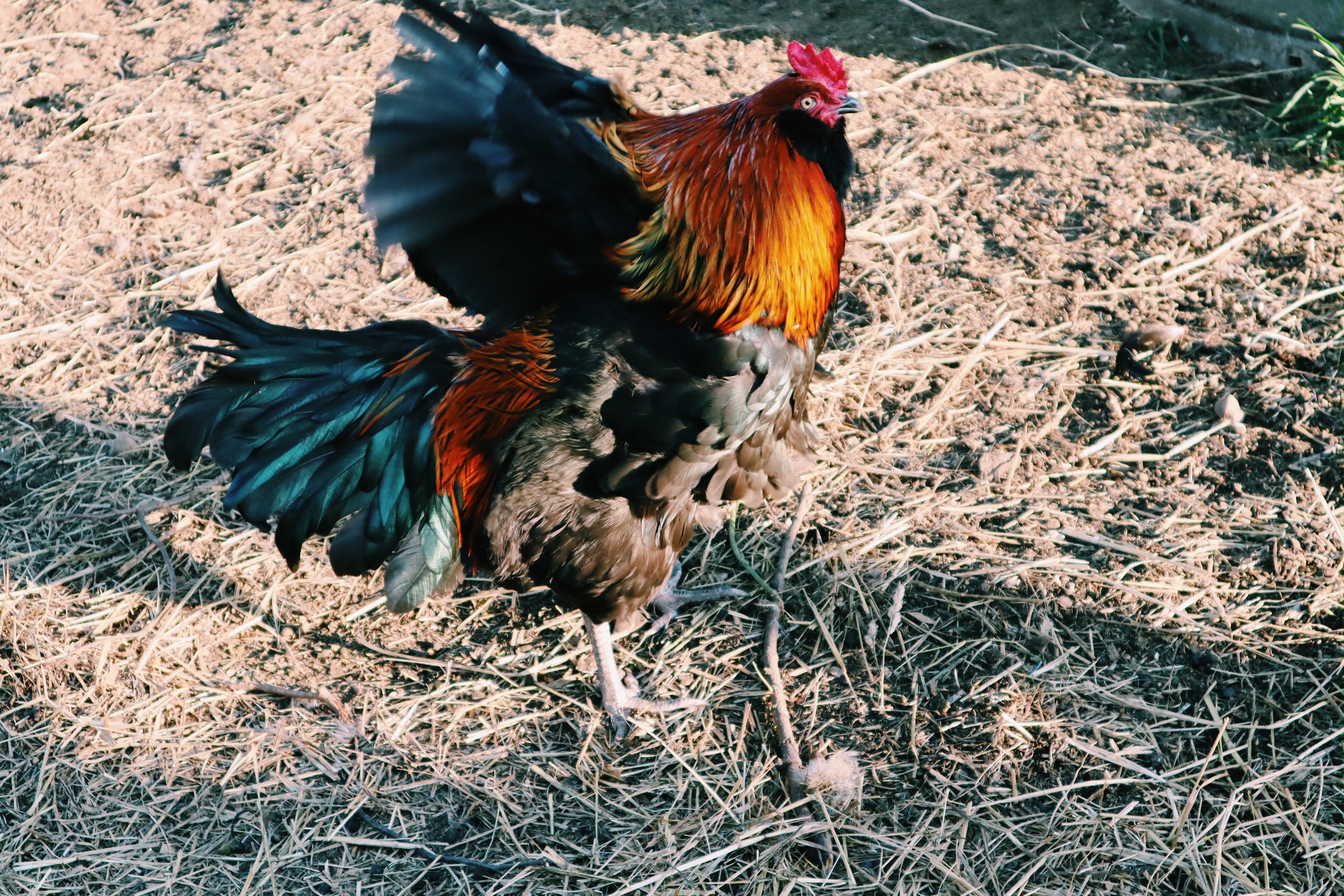Almost daily I see questions or comments on how to deal with rooster aggression. Unfortunately a lot of the responses to this question tend to be really cruel, things like “throw them in the crock pot,” “chicken soup for dinner,” “carry them upside down by their legs,” or even “hit them”.
Every time I see comments like this, it hurts my heart. Every animal has value, and deserves a chance to live their best life, especially when it’s a natural instinct for a rooster to be somewhat aggressive, and to guard its flock and protect them from predators.

In my experience, roosters are some of the most abused and misunderstood animals. At birth, they’re often killed simply based on their gender, and it doesn’t always get better for the ones that do live. For many people, the first sign of aggression leads to a rooster being cooked for dinner.
This is a problem. First, because roosters will often show aggression because they are trying to do their job, protect their flock. Second, there are often many strategies you can use to address the aggression in roosters, many times people are simply unwilling to give them a chance.
But you are here! Which means you are looking for an answer to address aggression, and I’m happy to share 10 tips with you to address aggression in roosters.
So how do you handle an aggressive rooster? Here are 10 Tips for Success!
1 Wear the right clothes
Before we start talking about how to handle the rooster, first think about what you can do on your end to protect yourself. This starts with wearing the right clothes. The best clothes for being around an aggressive rooster are thick jeans and tall boots. You may even want to add some gloves into the mix!
It’s easy to go outside in shorts and sandals, but you are more likely to get injured on your legs than anywhere else. Typically roosters attack by flying up at you with their spurs. This means your lower legs, below your knees, are most at risk.
While you are working on addressing the aggression, think about what you can wear to keep yourself from being injured in the first place!
2 Be aware of your surroundings
Another tip that is totally in your control? Pay attention to your surroundings! You’re most likely to get attacked when you’re not paying attention. Maybe you’re distracted by filling feed dishes, cleaning up, or walking out of the area, this is the time to really pay attention.
Pay attention to how you interact with your flock, as well as any environmental situations that the rooster may be perceiving as a threat. Think about it like this… you’re walking to your car at night in the city. How would you behave? You would be aware of where you are and who is around. So just pretend like you’re doing just that when you’re with your rooster. He may not steal your wallet, but he just might try to attack.

3 Spend time around him, in his territory
Your rooster may be trying to attack because he is not used to you. Maybe your significant other spends more time with the flock, or maybe you haven’t had your rooster for too long. Whatever the reason is, it is important for your rooster to get used to you being in his territory. So grab a cup of coffee and spend some time in the chicken run, yard, or coop. Oh, and make sure you follow tips 1 & 2 when you’re doing it.

4 Walk boldly

I truly believe roosters can sense fear. They read body language very well, and will use it to their advantage. If they perceive you as weak and afraid, they are going to be much more likely to attack. This is because of the way roosters operate, they are trying to be “top dog” and maintain their position in the flock. We will talk about this more under tip 9.
When you are with your aggressive rooster, embody confidence in the way you walk and interact. Think tall, strong, and bold. This way the rooster is going to be less likely to try to assert himself and attack you.
5 Pick him up and hold him
It is time for some rooster snuggles! Tips 5 and 6 are all about snuggling your rooster. Well, kind of. This is more about getting the rooster used to you handling him than anything else. Once he learns that you are in charge and are not a threat, he should stop trying to exhibit dominance through aggression.
Picking him up may be a bit of a challenge. Try to sneak in the coop in the morning or evening when your rooster is a little calmer. When holding your rooster, be sure to use a firm hold, they are strong and feisty little animals! Tuck him under your arm and make sure his wings are secured there, or else he may just fly away.
6 Pet him regularly
When holding your rooster, make sure to give him lots of pets. Again, this will get him used to you handling him on your terms. This will develop trust between you and your rooster. Trust is an important component of showing your rooster that you are not a threat to him, or his flock.
7 Feed him treats
You know the saying, “a way to a man’s heart is through his stomach”? It totally applies to animals too! Want to get on your rooster’s good side? Feed him some yummy snacks, and spend some time with him at the same time.
This is all about behaviorism. Think about how you would train a dog to sit: they do the command, they get the treat. When it comes to your aggressive roo, offer treats when he is not being aggressive, in a safe environment. This way he learns that he receives treats when he exhibits positive behavior.
8 Get another rooster
This next tip has worked well for us. Sometimes roosters need another rooster to work out their dominance issues. Think, “let boys be boys;” adding another rooster may curb the aggressive behavior by providing your rooster with another male member of the flock to balance out the dominance.

If you’re going to do this, it is important to consider the hen to rooster ratio. Typically about 8 to 10 hens for every rooster is a good rule of thumb; however, some roosters will fight no matter what the ratio, and other roosters will live peacefully together even if there are less hens present.
We actually have a rooster coop! Four roosters live together in a coop and run and so far it has been great for everyone. They have exhibited less aggression towards each other, and towards us, and they seem happy living out their life in the bro-coop.

9 Understand rooster behavior
To properly address rooster aggression, you need to understand why it exists in the first place. As I’ve mentioned, it may have to do with an attempt to fight of a perceived threat, which is actually a good thing! You want your rooster to exhibit aggression towards a predator, that way he will keep your flock safe.
Of course, you do not want your rooster to attack you, or your family, so the goal isn’t to remove the aggression, but to remove the aggression when it is directed at PEOPLE. Following these 10 tips, your rooster will learn to develop trust with you and will figure out over time that you are not a threat, and will not retreat when he shows aggression.

10 Make him retreat
When aggression does occur, or when your rooster shows signs of becoming aggressive, it is really important that you DO NOT run away or back down. You may be afraid, but you cannot let him see that. If he thinks you will back down and leave, he will continue to display aggression in an effort to chase you off (as a perceived predator) and protect his ladies.
So when your rooster begins to show signs of aggression, or starts to chase towards you, make him retreat, by walking boldly towards him. Another option is to grab a spray bottle or a hose (on a gentle setting), and to spray him when he tries to attack. This will “punish” him for the aggressive behavior and teach him that he will not get away with aggression.
Always remember when using any kind of punishment, that you pair it with positive reinforcement for the behavior that you want, see tip 7.
Bonus tip! Be patient, & don’t expect perfection
With any challenging behavior, it is important to practice patience. Often times when you implement new strategies to address behavior, you may even see a spike in the behavior. Do not be concerned if initially you notice a spike in aggression, this is normal.
Why? Your rooster thinks that if he becomes even more aggressive, you will leave him alone. When he realizes that his aggression does not lead to the results he wants, you will begin to see the behavior dramatically reduce.
So don’t expect perfection! After all, your rooster is meant to chase of predators, he is meant to act big and strong even though he is less than 1/10th of your size. As time goes on, you may continue to see occasional signs of aggression, but do not fret. Continue to follow these tips and you will keep yourself safe while also allowing your rooster to live out his life as king of the flock, or so he believes.
That’s all for now friends,
All my best,
Jenn
